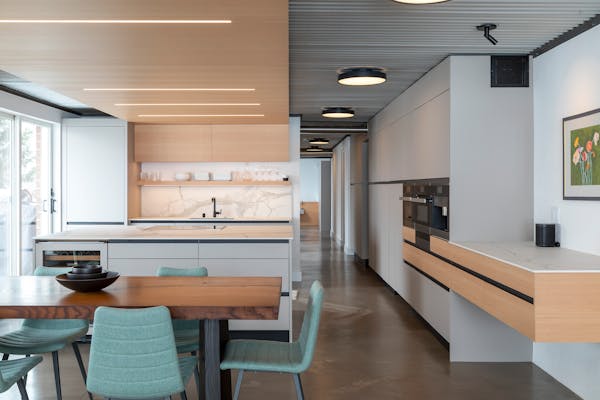As if channeling jazz hep cats of yore, young people today are all about vibes, trying to name a fleeting feeling or aura. Rural Retreat, a hilltop house in Wisconsin's Driftless Area, is giving sublime fulfillment vibes.
If the 3,000-square-foot structure in Soldiers Grove evokes the feeling of a fresh-baked baguette — a rough exterior that gives way to soft insides — it's because it incorporates two of the attributes that owners Chris Palm and Johanna Stirling most prized as they sought to build their weekend getaway.
The couple wanted to create an environmentally sustainable house that used as many salvaged materials as possible. They also wanted the place to be warmly inviting, as they plan to make memories there for generations.
Sustainable living
To wit, the house has walls of reclaimed ipe wood that Palm sourced from a weathered highway sound barrier in Chicago. And Douglas fir, highly rated for strength and durability, is used for posts, ceiling and trim, its orange-y gladiolus color adding to the allure.
"It looks rough and rustic on the outside but it's modern with a lot of glass on the inside," Palm said of the house. "Building it only took a few years off my life, but it was well worth it."
A winner of the Home of the Month competition sponsored by the Star Tribune and AIA Minnesota (American Institute of Architects), the project began in 2017 on land that Palm and Stirling acquired just 20 minutes from where Stirling grew up. The area — 3½ hours southeast of the Twin Cities — is famed for its variegated landscapes and microclimates prized by organic farmers.
The couple at the time lived in Minneapolis and often dined at their favorite restaurant, Tilia, which is near the office of architect Mark Larson, co-founder of Rehkamp Larson Architects. They looked him up online and were impressed.
The owners and designers set about plotting a house that was respectful of sustainability but durable and ready for big groups of friends. It was to be a countryside farmstead cabin — there was no lake or river to see — with the horizon as the prized view.
An eye on efficiency
One of the major challenges was not to build more than was needed, Larson said.
"We were careful about how we allocated space — looking for spatial efficiency."
In the main area, all the rooms are open to each other, creating an easy flow and making it seem expectant of gatherings. Easy access to outdoor spaces also makes the house great for get-togethers.
The living room has a wood-burning stove. The upstairs is relatively small. And the bedrooms are modest-sized. Douglas fir proved ideal aesthetically.
"We were looking for warmth throughout the house but didn't want it to be old-timey or cute," Larson said.
Stylistically, the house has vernacular farmstead origins, although it departs from the classic white farmhouse. With its washed-out exterior, it blurs lines between rural and urban, rustic and modern. And Larson and his team, which includes Laurel Johnston and Ryan Bicek, were keen to emphasize the link between outdoors and in, with outside cladding carried throughout the structure.
For the roof, the design team went with a painted steel that readily sheds rain and snow and lasts a long time. It reflects heat in the summer and potentially could be recycled at the end of its life. And the base of the house is wrapped with Corten steel that will take on a rusty patina with age.
"It's a series of three sheds, in a way," Larson said. "It's a healthy, interesting tension between the rough and the finished."
An active family
Both active and athletic, Palm and Stirling met at Macalester College, where he played basketball, soccer and tennis and she ultimate Frisbee. He's into finance and real estate. She's a medical professional. The couple have three children — Annika, 11; Marina, 9; and Anders, 5 — all of whom are into soccer and skiing.
When the pandemic shut down everything, they retreated to their farmstead, spending 2½ months of remote work and learning.
"I like waking up in the morning looking out over a field and forest covered in fog with the sunrise peeking through," Stirling said. "It's magical and serene."
While the house has a lot of glass, it's net-neutral. Design choices included triple-paned windows and a lot of insulation, so the heat from the south carries to the north of the house. Solar panels for energy were also drawn into the blueprint.
The family has enrolled in the Conservation Reserve Program, with 40 acres dedicated to monarch butterfly habitat. Palm also has started tapping maple trees and expects to bottle 300 gallons of maple syrup from 700 trees this year.
All this activity — and the attendant feelings and memories they generate — swirls around their retreat, which Palm describes as a slice of heaven.
"There's a lazy spring-fed creek nearby and we go tubing there for hours," Palm said. "It's unique and pretty special."
About this project
New durable and raw materials as well as salvaged items were used to create a rural retreat amid farmland and river valley in southwestern Wisconsin's Driftless Area.
Designing firm: Rehkamp Larson Architects.
Project team: Mark Larson, AIA; Laurel Johnston, AIA; Ryan Bicek, AIA.
Project partners: Bad Axe Log Homes & Supply, general contractor: Brooke Voss Interior Design, interior designer.

The 5 best things our food writers ate this week

A Minnesota field guide to snow shovels: Which one's best?

Summer Camp Guide: Find your best ones here

Lowertown St. Paul losing another restaurant as Dark Horse announces closing


